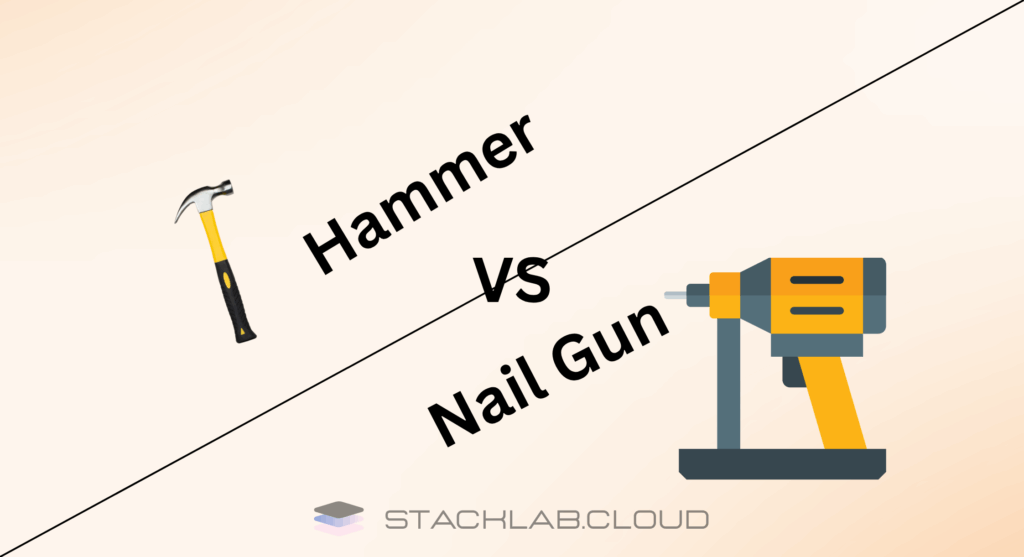Understanding EC2 Instance Types: A Simple Guide
When you launched your first EC2 instance, you likely selected the t2.micro type because it was part of the AWS Free Tier. But what does “t2.micro” actually mean? And how do you choose from the hundreds of other available options?
The Instance Type is one of the most important decisions you’ll make when launching a server, as it determines the virtual hardware powering your application. Choosing the right one is key to balancing performance and cost.
This guide will demystify AWS EC2 instance types. We’ll break down the naming convention and explain the main instance families so you can make an informed decision for your next project.
The Best Analogy: Buying a Tool

Imagine you need to do a job around the house. You go to a hardware store and see a wall of tools.
- For hanging a small picture frame, you just need a simple hammer.
- For a major construction project, you need a powerful pneumatic nail gun.
Using the nail gun for the picture frame would be expensive and wasteful overkill. Using the hammer for the construction project would be slow and ineffective.
EC2 instance types are just like that. They are specialized tools designed for specific jobs. Your goal is to pick the right tool for your application’s workload.
Decoding the Instance Type Name
An EC2 instance type name, like t4g.medium, might look confusing, but it’s a code that tells you everything you need to know. Let’s break it down.
- Instance Family (The ‘t’ in t4g.medium)This is the first letter and it tells you the primary purpose of the instance. T instances are for general-purpose, burstable workloads, while C instances are for compute-intensive tasks.
- Instance Generation & Processor (The ‘4g’ in
t4g.medium)- The number (
4) indicates the generation. A higher number is always newer, faster, and often more cost-effective than a lower number (e.g., at4gis newer than at3). - The letter (
g) often indicates a special feature, most commonly the processor type.gstands for Graviton, which are custom-built, energy-efficient ARM processors made by AWS. Instances without a letter typically use Intel or AMD x86 processors.
- The number (
- Instance Size (The ‘medium’ in t4g.medium)This tells you the relative size of the instance within its family. The sizes range from nano and micro up to large, xlarge, 2xlarge, and beyond (e.g., 24xlarge). A larger size always means more vCPUs (virtual CPUs) and more RAM.
The 5 Main Instance Families for Beginners
While AWS has many specialized families, most use cases fall into one of these five main categories.
1. T-Family: General Purpose (Burstable)
- What it is: These are the most common instances. They provide a baseline level of CPU performance but have the ability to “burst” to a much higher performance level for short periods when needed.
- Best for: Websites, blogs, development/test environments, and small applications where CPU usage is generally low but has occasional spikes. The
t2.microandt3.microare the most popular Free Tier instances.
2. M-Family: General Purpose (Fixed Performance)
- What it is: The M-family provides a balanced and fixed amount of CPU, memory, and networking resources. Unlike the T-family, their performance doesn’t “burst”; it’s consistent.
- Best for: A wide variety of workloads like web servers, small-to-medium databases, and general enterprise applications that need consistent performance.
3. C-Family: Compute Optimized
- What it is: These instances are “compute-heavy.” They have a high ratio of CPU power relative to their memory (RAM).
- Best for: Workloads that require intense processing power, such as scientific modeling, high-performance web servers, media transcoding, and batch processing.
4. R-Family: Memory Optimized
- What it is: These instances are “memory-heavy.” They have a very large amount of RAM relative to their CPU power.
- Best for: Workloads that process large datasets in memory. This includes large-scale databases, real-time big data analytics, and in-memory caches.
5. S3-Family: Storage Optimized
- What it is: These instances are designed for workloads that require high, sequential read and write access to very large datasets on local storage. They come with extremely fast, local NVMe SSDs.
- Best for: Data warehousing, distributed file systems, and applications that need extremely fast access to large amounts of locally stored data.
Conclusion: Choosing the Right Tool for the Job
You don’t need to memorize all 400+ instance types. Instead, understand the families. By starting with the right family, you can ensure your application has the right balance of resources.
For most beginners, starting with the T-family (
t3.micro) is the perfect choice. As your needs grow, you can then analyze your application’s performance. Is it constantly running out of memory? Move to an R-family instance. Is the CPU always at 100%? Move to a C-family instance.
By choosing the right instance type, you ensure you are only paying for the resources you need, which is the core principle of building efficiently in the cloud.
Read Next: What is AWS S3? A Complete Introduction to Cloud Storage











